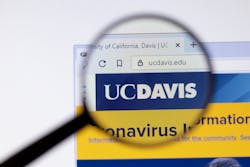Last November, UC Davis Health announced that it would launch a Cloud Innovation Center in partnership with Amazon Web Services (AWS) with a focus on digital health equity. At a recent AWS conference, Keisuke Nakagawa, M.D., executive director of the new center, described some lessons learned about the challenges and benefits of open innovation in this setting.
The Cloud Innovation Center is being set up to explore difficult issues around providing equitable care to a diverse patient population. This includes issues around remote patient care, discrepancies in technology used for healthcare, transportation, or mental health that could be improved to better serve a diversity of patients. Projects will be driven by clinicians, patients, and the community-at-large who will submit their challenge ideas.
Nakagawa said he remembers being taken aback when the AWS team first talked about making the center’s work all open source. “They said they open-source everything — the code, the reference architecture, the business requirements, documents, the mockups, everything is completely open source, because this is an open innovation program by design,” he recalls. “Initially, I thought that was really cool. But I also was thinking, how the heck am I going to convince our tech transfer office, our faculty, our leadership to buy into that? Well, it wasn't the prettiest ride. But I can tell you, our general counsel was actually one of the first ones to understand the value of open innovation.”
He talked about some of the early experiences engaging with customers in some of the challenges. Ultimately, the goal of the Cloud Innovation Center is to bring a diverse mix of people to the design table early on, Nakagawa said. That includes patients, the community, and the clinicians, who are often not at the table early enough in that innovation process. They also want to create a more universal framework around digital health equity.
“Right now, so much of our conversation around digital health equity is around the people, but I think it's very important that we broaden that definition of health equity to include health systems, and actually the organizations that are working with communities,” Nakagawa said. “If you think about it, there are so many health systems that are under-resourced, and they're actually the ones that are caring for the patients who have been falling into that digital divide. If they're not part of that innovation equation, then their patients are not represented in the data, and they're not represented in the design of the next generation of digital technologies.”
When they started working with other organizations, he said, one thing they noticed is how hard it is for people to stay in the discovery mindset before jumping straight to solving the problem. “It's natural for the reaction to be: we have a good understanding of the problem; let's now figure out how to solve it. But we are still trying to figure out how to create a viable open innovation framework or an open innovation model that can really unlock value in healthcare and reduce health inequities and health disparities. There are a lot of issues that we're working through, and figuring out what toolkits even need to be set up and prepared for a lot of the challenge sponsors. For example, we're looking at synthetic data. What happens if we open-source synthetic data based off of real patient data? If we have that kind of capability, can we accelerate research? Can we co-create and co-curate data sets across many different health systems across the country, around the world, to create a much more comprehensive, equitable data set that can drive better care and much more equitable care? So we're still trying to figure a lot of these issues out.”
They also have to work through having partners process the idea that everything is going to be open source at the end. “They ask: If we prototype an app, is that also going to be open source? And we say, yeah, that's going to be posted on GitHub,” Nakagawa said. “Once you overcome that initial reaction, it's amazing to see how much the air in the room changes because now all of those IP issues that typically weigh us down or prevent us from collaborating so fluidly are completely gone. It allows these multidisciplinary teams to really invest in the mission, and the mission really becomes front and center.”
As an example, the Cloud Innovation Center is working with thoracic surgeons to develop an open standard for electronic patient-reported outcomes for cardiothoracic surgery, so that it's easier for any patient to be able to report patient-reported outcomes. “That is critical for ensuring digital inclusion, because we need to make sure that all the patients that are receiving cardiothoracic surgery are represented in the in the data set of what is happening post-operatively,” Nakagawa said. It can also help surgeons understand when patients need to be managed more carefully, or called back in. “A lot of the opportunity is making sure that we're actually broadening the ultimate data set of post-operative cardiothoracic surgery patients, which can then drive a lot of new insights and ensuring that the care that we're delivering and receiving is as more equitable,” he added.
“Ultimately, because this is going to be open source, we're really starting to create an open standard for electronic patient-reported outcomes that can be used for any other medical association that's interested in it, whether it's the American College of Surgeons or other organizations,” Nakagawa explained. “It really offers a much more scalable architecture that allows for potential interoperability of others are using a similar framework.”
The Center also is supporting a grant-funded project that is looking to increase the rates of lung cancer screening among Black populations by 200 percent. “We are looking to create a model of care and a model of engagement with these patients so that they feel more included and more empowered to come and get the lung cancer screening that they need,” Nakagawa said. “A lot of this also naturally touches on digital literacy and health literacy to ensure that all of those dots are connected for patients to come and get the lung cancer screening that that they need.”
Nakagawa left the audience with a final question: Is health equity and health justice even possible without open innovation? “As we go on this journey, and if you're thinking about these questions, we ask you to consider joining our Cloud Innovation Center through sponsoring challenges or participating in challenges so that we can really work together to reduce health disparities through this open innovation model.”


